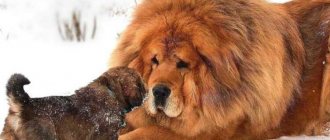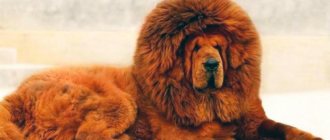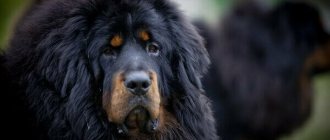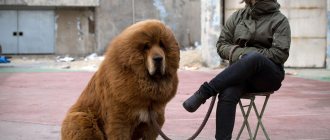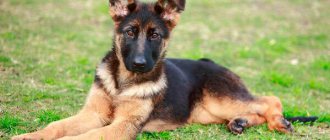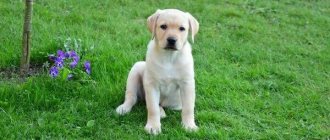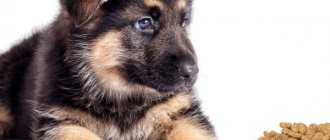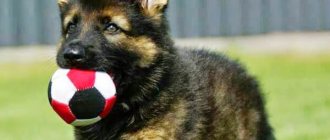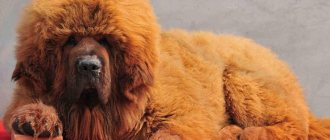Before you get a four-legged pet, you need to carefully study all the characteristics and features of the breed you are interested in. This is extremely important, since dogs have individual characters, sizes, habits, temperaments, preferences and much more. In our article we will talk about the Tibetan Mastiff breed, photos and pictures of which you can see below. This species belongs to the most ancient representatives of watchdogs and was used as an assistant in the protection of monasteries in Tibet and Nepal, and acted as a protector of nomadic families and their livestock from unwanted guests.
Origin story
There is no exact historical data regarding the origin of one of the largest dogs in the world - the Tibetan mastiff. Sources vary greatly in information and facts about the appearance of the breed, and are also embellished with various legends and myths. Some information says that their ancestors are black Himalayan wolves, while others claim that the genus of the Tibetan mastiff came from the guard dogs of Chinese traders who plied the mountains of Tibet. It is known for certain that the first written mentions of shaggy giants date back to 1121 BC. An entry in the Chinese chronicle Shu King says that mastiffs protected the homes of monks, temples and herds of domestic animals from the attacks of predatory snow leopards and from other, no less aggressive inhabitants of the mountains.
Myths and legends, as well as beautiful traditions, say that the first dogs of Tibet belonged to the Buddha himself and the brave Genghis Khan. Dog experts hypothesize that purebred varieties of Tibetan mastiffs are the ancestors of all current breeds of four-legged molossoid species, which includes such famous dogs as St. Bernards, shepherd dogs, Rottweilers, boxers, Great Danes, etc.
The first European notes about the shaggy giant were recorded in 1847. This year, the shaggy puppy was presented as a gift to the English monarch, Queen Victoria. Documented standards for the Tibetan Mastiff breed were recorded in writing in Europe by the Berlin Zoo only in 1898.
Representatives of this species are quite rare and expensive pets. Their value is due to the fact that they were able to preserve their appearance and characteristics almost in their original form. The inaccessible Himalayan mountain range protected the breed from external influence from the southern border, and from the northern border this function was performed by the desert. This contributed to the fact that the appearance of the animals remained original, unchanged and impressive.
How sensitive guards and loyal family friends won the recognition of humanity
Many countries and peoples have written their pages in the history of the appearance and further spread around the globe of the large Tibetan mastiff.
Chinese scientists who conducted genetic research in the field of separating the DNA chains of a wolf and a dog made the assumption that the process occurred more than 40,000 years ago; the approximate “date of birth” of the breed of interest to us is considered to be a period of more than 50,000 years ago.
The conclusion suggests itself: Tibetan giant dogs are one of the first dog breeds on the planet. The Mastiff's "closest relatives" are the Great Pyrenees, Bernese Mountain Dog, Rottweiler, Saint Bernard and Leonberger.
The ancestors of these breeds quite likely had passionate affairs with each other, which was the reason for the appearance in the future of these well-known large pets.
Throughout the history of mankind, Tibetan Mastiff puppies have become a generous gift or trophy for the winners of certain battles.
The victorious march of the unique breed across the planet began back in the 10th century (it was at this time that the first writings about the unusual family of dogs appeared) and continues to the present day.
A major role in the spread of mastiffs around the world is given to the ubiquitous Romans, great lovers and connoisseurs of the dog breed. The Roman legions, roaming the planet in order to conquer territories and establish their dominance, became the unwitting reason for the first timid appearance of the breed in Europe.
Officially, Western society became acquainted with the Nepalese and Indian guards in 1847, when the English aristocrat Lord Harding presented Queen Victoria with a magnificent male of the Tibetan breed named Siring; this moment became key in the process of spreading mastiffs across the European continent.
Giant dogs came to America a little later, first as a gift to President Eisenhower, then through mass importation from the heavenly lands.
About the breed
The Tibetan Mastiff is a very large and strong dog with a well-developed muscular physique. Its peculiarity is a long and thick coat with abundant thick undercoat, which creates a kind of mane in the neck and forearm area. This trait gives the breed an amazing resemblance to lions; the animal looks menacing and angry. The dogs are very hardy, they tolerate both cold and hot days well, thanks to which they can safely live outside all year round. The weight of an adult individual ranges from 59 to 85 kg, reaching a height at the withers of 61 – 78 cm.
The characteristics of the Tibetan Mastiff allow it to be used as a companion, guard or even bodyguard. The dogs are smart and well trained, friendly and incredibly loyal to their owner. True, the animal will be able to perform its functions 100% only after reaching adulthood, for boys this is 2-3 years, girls mature only at 4 years. This species has excellent sexual characteristics - males are much larger than females.
What does a puppy look like in the photo at 4 months old?
At 4 months, a Tibetan Mastiff puppy already looks quite scary.
His height is 43-48 cm, and his weight is 20-33 kg . That is, he has already reached the size of an average adult dog. Internally, he is still a puppy who needs control and education.
At this age, puppies also begin their active growth phase. At 4 months the dog looks like a smaller copy of an adult dog. The proportions are maintained, but sometimes you can notice that one of the body parts is larger than the rest. This disproportion will disappear with age.
At 4 months, the color may already be determined, but this does not mean that it will remain that way throughout the dog’s entire life . It also happens that over time the color of the Tibetan Mastiff's coat may change.
In other breeds, puberty may already begin at 4 months. This is not the case with Tibetan Mastiffs.
They mature for a long time, up to 3-4 years.
Dog character
The Tibetan Mastiff's personality has been described as balanced, calm, gentle, friendly and patient. But this is inherent to him only if there are no irritants from outside. When the owner, family or home is threatened, the ability to make decisions, quick reactions and aggression are manifested. The Great Dane perfectly protects the territory entrusted to him and his household from any danger. The breed is one of the highly intelligent representatives of four-legged pets, this is a consequence of the fact that in Tibetan houses it was normal to leave the mastiff in charge of the elder, children and livestock were entrusted to them, the dog itself monitored the maintenance of order.
Dogs of this species perfectly understand their own self and are independent family members who require equal treatment and can sometimes refuse to obey. Along with this, they are very reserved and loyal, they get along well with other dogs and cats, if they are peaceful and do not show arrogance and anger. Tibetan Mastiffs are very warm towards children and can easily become excellent nannies. They are tolerant and perfectly understand their size: if a dog plays with a small child or a person with disabilities, then it will never make awkward movements that could cause injury.
If the pet is used exclusively for security purposes, then it is important to understand that its activity occurs more at night; during the day, shaggy household members are most often drowsy and inactive. It doesn’t have any negative characteristics as such, but everything is individual.
What to feed (by month)?
Feeding the baby should include foods that will provide the body with the necessary vitamins and microelements and maintain its health.
In order for your pet to tolerate all hygiene procedures calmly, he needs to be accustomed to them from an early age.
Since large dogs have a lot of stress on their limbs, their diet must contain sufficient calcium.
Feeding both puppies and adults of the Tibetan Mastiff can be done with ready-made food or natural products. You cannot add another to one type of food.
During intensive growth, puppies need a lot of food for proper development. Adults eat somewhat less. It is important to feed in moderation, and also to ensure that the animal eats slowly. It must eat food within at least 20 minutes.
If you feed natural products, then preference should be given to the following:
- beef, rabbit, turkey, chicken;
- sea fish;
- offal;
- cereals (rice, buckwheat);
- fermented milk products;
- vegetables and herbs sometimes include fruits.
During intensive growth, puppies need a lot of food for proper development.
Puppies are given minced meat. Approximate diet of individuals under one year of age :
- from birth to 2 months. – fed with dry protein food;
- from 2 to 6 months. – meat products are added to the feed: liver, heart, tripe, as well as vitamins;
- from 6 to 12 months. – food with low protein content, meat, offal, vitamins (including omega acids), drugs from the group of chondroprotectors.
The grown young animals are gradually transferred to adult food, starting with adding a small amount of adult food. The volume of food for puppies is reduced, and for adults it is increased.
Breed standards
The standards of the Tibetan Mastiff are characterized by many breed indicators and descriptions, these are not only the correct proportions of the body and general appearance, but also temperamental characteristics, color, size and weight.
The main characteristics that define the breed:
- The head is massive, weighty and strong with a large skull, with folds from the tips of the eyes to the edges of the mouth. The frontal part is wide, a tubercle on the back of the head can be easily felt;
- Muzzle with a square end and a blunt edge;
- Powerful jaws with a perfect scissor bite and well-defined lips that completely cover the lower row of teeth;
- The eyes are dark brown, medium-sized, oval-shaped, widely spaced closer to the edges of the head;
- The ears are hanging, medium in size, triangle shaped, slightly covered with soft down. In case of anxiety, they rise;
- The neck has an arched shape, strong structure, with a small dewlap. It is characterized by a long and dense mane-like coat;
- The back is level, the body is large with a well-developed muscular system and a wide, egg-shaped chest;
- The tail is of medium size, lush, smoothly transitions from the dorsal line, has a right or left curl with a beautiful long pile;
- The paws are proportional to the body, massive, and have a regular, even shape.
Weight by month
As mentioned above, in the description of the Tibetan Mastiff breed, dogs do not mature quickly and reach maturity only by 3–4 years. Newborn puppies are born bald with a weight of 400-500 grams, then in the first month of life they gain up to 5 kg and continue at this rate right up to the fourth month, respectively 11 kg for the second month, 15-16 kg for the third and 17-18 kg. fourth. Then there is a weight jump of as much as 7-8 kg and at 5 months the Tibetan Mastiff puppy already weighs 24-25 kg. Over the next seven months, the baby adds 3-4 kg to his body weight and by the age of one year he already weighs 41-44 kg. Every six months following, the four-legged miracle increases by another 5 kg and at two years of age reaches 53-54 kg, respectively. Depending on the feeding ration, each subsequent year the dog gains another 3-4.5 kg and at the peak of its development weighs about 60 kg.
Maximum height and weight
Some specimens of an adult Tibetan mastiff can reach a weight of 88-90 kg and have a height at the withers of up to 80-85 cm.
The largest and most expensive
The Tibetan Mastiff breed is one of the largest in the world and its largest representative, as well as the most famous and expensive, is a male named Big Splash, originally from China. His weight is truly impressive and equals 113 kg. This red baby at 11 months of age already weighed as much as 80 kg. He is also the most valuable dog on the planet and cost his owner $1.5 million. The diet of this pet includes the best varieties of chicken and beef meat, as well as exclusive seafood, which pays off handsomely, since mating with this giant costs more than 15 thousand dollars and the queue for it is impressive.
Appearance from photo
As stated above, this is a huge and muscular breed. Pupils of the Tibetan Mastiff, whose height at the withers reaches 68-78 cm, have a luxurious, voluminous, thick coat with a warm undercoat, which can be seen in the photographs and pictures below.
Coat type and color
The coat of this type of mastiff is unique in its appearance and composition - an abundant elongated pile with a very thick undercoat allows the animals to feel good in the harshest winter conditions, they sleep peacefully in the snow and tolerate icy mountain winds well. As described above, in the neck area the hair has a special length and visually resembles the mane of a lion.
The color of Tibetans is varied and is represented by the following options:
- Black;
- Ginger;
- Brown with iridescence;
- Golden;
- Red;
- Fiery;
- Fiery red;
- Red-orange;
- Chestnut, different shades of gray and blue.
There may also be combined colors with tan inserts in the eye area, on the tip of the tail and all paws.
Is there such a thing as white?
A very rare occurrence is the birth of a white mastiff puppy, which you can see in the photo below. Due to the enormous difficulty of breeding this color, white color is not accepted as a standard. The white Tibetan is a very expensive dog, it looks gorgeous, its cost is estimated at 1 million dollars or more.
Proper care and maintenance
Caring for furry babies and big giants is no different from caring for standard dogs, but requires some nuances, which will be discussed. You can keep such red babies nearby both indoors and outdoors, but the second option is most preferable.
Shedding
Tibetan mastiffs do not shed frequently; this phenomenon occurs once every 365 days. In some natural zones, molting is completely absent. But when the shedding period begins, the hair falls out in clumps, which is a feature of the breed. Despite this, caring for your pet’s fur is quite simple. Caring for them can be compared to caring for shaggy German Shepherds. You only need to comb the soft undercoat a couple of times a week and give vitamins for the lint. As soon as the shedding has passed, fur care is reduced to once every seven days.
Contents of the Tibetan Mastiff
Tibetan Mastiffs are dogs that require close attention, as well as compliance with a number of rules that will help maintain the physical and mental health of your pet. This series of rules includes the organization of a healthy diet, and most importantly, a balanced diet in terms of nutritional components, as well as the organization of physical activity, etc. This breed can be kept both in an apartment or a house, but also on the street, in the open air.
Care and hygiene
Since the pride of the Tibetan Mastiff is its thick coat, it requires careful care, especially during periods of shedding. It is equally important to take care of the animal’s eyes, ears, teeth and claws. That's why:
- During periods of shedding, you will have to comb the animal's fur 3 times a day.
- You will have to bathe your dog about 2 times a year.
- If tangles appear, the latter must be carefully cut out using scissors.
- You will have to brush the animal’s teeth a couple of times a week, as well as monitor the process of changing teeth and the general condition of the gums.
- Nails are trimmed twice a month with a special nail clipper.
- When returning from a walk, the animal needs to thoroughly wash its paws.
- The ears are inspected and wiped with damp sanitary wipes.
- The eyes are washed from time to time with an infusion of medicinal chamomile.
Interesting to know! To choose a worthy pair for your pet, it is advisable to contact nurseries that practice breeding a similar breed. This will not cause deviations in breed standards and will contribute to the further development of the breed.
It is also necessary to know that this breed matures relatively late, so individuals older than 4 years should be bred.
What to feed
The well-being of the Tibetan mastiff and its longevity depend directly on proper feeding of the animal. In this case, the animal can be fed both natural food and ready-made dry food. As a rule, mixing these two types of nutrition is strictly not recommended.
As experts recommend, it is better to give preference to natural food. A puppy under 2 months of age is fed 6 times a day, distributing food proportionally. The main types of foods that can be fed to a mastiff include:
- Lean meat, such as turkey or beef.
- By-products must be thermally processed.
- Fermented milk products, in the form of kefir, cottage cheese or acidophilus mixture.
- Cereals such as rice or buckwheat.
- Boiled eggs, no more than 2 per week.
- Boiled vegetables such as carrots, cabbage or pumpkin.
- Fresh fruit, including apples.
- Vegetable oil of any origin.
- Dried fruits, cheese and raisins are used to encourage the training process.
- Various greens.
You need to know this! The animal's daily food intake is about 4 percent of the animal's weight.
To balance the diet, vitamin and mineral complexes should be added to the food. Their use must be agreed with a specialist. From 2 months to 6 months of age, the animal is fed 5 times a day. At the same time, you can introduce boiled fish into your diet, removing the bones from it.
Diseases and breed defects
The Tibetan Mastiff breed is susceptible to a number of infectious diseases. For example:
- Nervous plague.
- Parvovirus enteritis.
- Rabies.
- Infectious hepatitis.
If you get the necessary vaccinations in a timely manner, you will be able to protect your animal from many dangerous ailments by protecting its immunity. Diseases associated with the characteristics of the breed are: hip dysplasia, malignant neoplasms and allergies. This can also include osteochondritis, bone dystrophy and dermatitis. Any deviation from accepted breed standards is associated with deficiencies, and their degree depends on the level of possible deficiencies.
Breed defects are associated with manifestations of various inconsistencies, not only of a physical nature. For example:
- Light or excessively wrinkled scalp.
- Saggy lips.
- The presence of a clearly visible suspension.
- Large or not too high set ears.
- The eyes are light with a wide open look.
- The nose is not brightly colored enough.
- Barrel-shaped rib part of the body.
- The tail is curled tightly at the hip area.
- Heavy and too constrained movements.
- Short stature beyond established standards.
Overly aggressive or overly indecisive individuals, or with an incorrect bite, are not allowed to be shown. The same applies to dogs that have a non-standard body color. Dogs with obvious breed deviations from the standards are also subject to exclusion.
Education and training
A dog of this breed needs early, mandatory education, which is associated with adaptation processes. Animal training is related to:
- With mandatory socialization.
- With imprinting.
- With the study of a mandatory training course.
The course of socialization and raising a puppy is associated with possible difficulties, since the puppy often shows stubbornness and aggression. This is due to the peculiarities of the animal’s behavior, due to the mastiffs’ sense of self-esteem.
Important to remember! After the imprinting course has been mastered, you should begin the stage of socialization of the animal. This stage is associated with the animal learning to adequately respond to the world around it and to human society. A socialized animal can easily learn the entire course of basic training and commands.
Imprinting is the process by which a dog begins to trust its owner. Such training, associated with the first stage of education, teaches the dog to react correctly to surrounding events, including to humans.
Tibetan Mastiff #1.// Ideal dog. The best watchman.
Breeding: heat, how many puppies does she give birth to?
The first menstrual cycle in a female dog occurs at eight months of age and is repeated once a year, most often in late autumn. The animal's immunity weakens, and it requires special attention and care: the fur should not be allowed to get wet and hypothermia. The first mating can be done only at more than two years of age. The gestation period usually lasts between 54 and 66 days. At this time, the dog is especially aggressive and only allows its owners to approach it. Childbirth is slow. In one litter, the bitch produces offspring of 5-12 cubs, which are born almost bald.
Dry food
- You need to choose premium or super premium or holistic dry food. These include the following brands of food: NOW FRESH, Grandorf, Acana, Orijen, Eukanuba, 1st Choice, Brit Care.
- The dog also needs to be fed this food 3-4 times a day;
- The dosage is indicated on the packaging.
NOTE!
When purchasing, do not forget to choose food for large breeds.
Can you keep it on a chain?
Under no circumstances should this breed be kept on a leash. Constant keeping in an enclosure is also contraindicated; it should be closed there only when absolutely necessary, when strangers are in the house. The cage for the Tibetan Mastiff is made spacious and strong; it is not recommended to install a thin wire mesh or chain link.
If a Tibetan dog is left to roam in the yard, the fencing system should be of an appropriate height.
Peculiarities
This breed is not suitable for city apartments - it grows to enormous sizes
Dogs of this breed have been recorded weighing in excess of 100 kg on numerous occasions, so it is important to provide plenty of free space. They are active in the evening and in the morning, this is important to consider when choosing a puppy
This is an intelligent and independent breed that needs early socialization. A confident person, a leader, must train and raise a puppy. This animal is not suitable for small children - its size is too large. In addition, he may misunderstand some of the children's actions. Adapts well with other dogs and cats if raised in the same house with them.
How many times should I wash and comb?
Bathing procedures for the Tibetan Mastiff should be carried out as needed, but it is recommended at least once a quarter. This is explained by the fact that despite the dense wool, household members of this breed practically do not have any unpleasant odor. After washing, the animal must be combed and dried with a hairdryer, the air flow of which must be directed against the growth of the pile. This is necessary in order to achieve maximum fur fluffiness. Tibetans are combed one to three times a week, depending on the condition of the coat.
How to cut your hair?
There are no special features of the haircut process. A hygienic haircut is desirable, but not required. It is needed when there are fur tangles in the wool that cannot be sorted out or combed out. Decorative or seasonal haircuts are carried out solely at the discretion of the owners. The only requirement is not to cut the hair too short, as the animal may catch a cold and get pneumonia. Ideas for haircuts for Tibetan dogs can be found in photos in pet catalogs or animal hairdressing salons.
Training and education
Tibetan Mastiffs and humans get along well, but the breed is sometimes difficult to train at home. Expert breeders recommend sending puppies to canine centers to undergo an obedience course. Training begins with mastering simple commands, such as “Ugh!”, “Lie down!”, “Come to me!”, “Near!” etc. In the first year of life, skills are trained according to commands, and in subsequent years they are consolidated and endurance is developed.
A Tibetan is a student who requires respectful treatment, and not just giving commands. First of all, he is a friend, not a servant, and it is important to understand this.
How to train and what commands to teach?
The Tibetan Mastiff is a calm and slow dog, which means training should take place in the same spirit. There is no place for haste and fuss. At the same time, this dog is a leader and special skills will be required here.
Commands you need to learn:
- "Place" . Usually, after a meal or a walk, the puppy wants to rest, but he can sit anywhere. And this is the time to learn. Take the baby to his place and firmly say the command. Do this every time your pet lies down (example in the photo).
- "To me" . Accustoming to this command occurs during a walk. A leash is used as an assistant. Without releasing the dog from the leash, say the command loudly and lightly pull the leash; when the baby approaches, praise him. Repeat the procedure every time you walk.
- "Walk" . This command is taught to the puppy when getting ready for a walk. While putting the leash and collar on him, calmly say the command several times.
- "Sit" . In order to accustom your dog to the command, hold a treat in your hands and say loudly “Sit”, while using your other hand to press on the pet’s croup. When the puppy sits, praise him and give him a treat.
- “Fu” - training to this command occurs strictly, and treats are not used. Whenever your dog does something that is not allowed, say the command firmly and distract your pet with something. The main thing is to let your pet know that you are not happy with his actions.
Health and life expectancy
Shaggy fire giants are naturally endowed with excellent health and long life. The average lifespan of a four-legged pet ranges from 13-15 years, but there are also long-livers, albeit under proper living conditions. Due to their large size, dogs are prone to ailments of the paw joints, so an annual X-ray examination is recommended.
Diseases of the breed
As mentioned above, animals of this breed are distinguished by endurance and good health, but still, like all living beings, they are characterized by some diseases:
- Dysplasia of the pelvic and hip joints;
- Allergic reactions;
- Diseases of weak bones and bone tissue;
- Malignant tumors;
- Dermatitis and osteochondritis;
- Rabies, plague and hepatitis of infectious origin.
Timely vaccination will avoid most illnesses and protect the giant’s immune system for many years.
Important! Systematically take your household member to the veterinary clinic for a routine medical examination and the doctor will always be able to identify early symptoms of disease and prescribe adequate and timely treatment.
Diet and feeding rules
In order for your four-legged friend to lead an active lifestyle and feel good, you need to properly organize his nutrition. This breed of dog is not at all picky about food and eats relatively little.
For purebred puppies, an excellent diet will be beef or horse meat, raw and boiled, heat-treated offal, vegetables, a variety of cereals, milk and fermented milk products (cheeses, kefir, cheese).
Adults are fed beef and veal, seafood, bird eggs and the same set of products that are used for puppies.
It is necessary to ensure that the animal always has clean water and food includes the required amount of vitamins and microelements. If you use food, then choose only trusted manufacturers and those that are specifically intended for the Tibetan Mastiff breed.
Which is better: natural or dry food?
First of all, you need to know that at first you need to feed the puppy what the breeder gave him.
In the future, the choice of food is up to you, but both natural and artificial food have their own disadvantages and advantages:
- Natural food contains natural vitamins and minerals. You will know exactly what you are feeding your pet. But such cooking requires a lot of time, moreover, you must create a properly and balanced menu so that the dog receives all the necessary nutrients.
- Artificial food immediately contains all the vitamins necessary for a dog’s health; no additives are needed. Another thing is that you cannot be sure whether the composition on the package matches the contents. Also, the use of industrial feed is not time-consuming.
Thus, the owner must choose for himself which food is optimal for his dog, weighing all the pros and cons.
Owners of Tibetan Mastiffs
most often use natural dog food .
Expert opinion
Kozhevin Semyon Kirillovich
Expert dog handler.
“Our nursery has always used only natural food for this breed. It’s hard to imagine feeding Tibetan mastiffs artificially. This breed requires a careful and individual approach; you cannot buy such an “approach” in a store. Some puppies need more food, some less, plus vitamins, because raising such a breed is not at all easy. Keeping a mastiff for fun will not work, nor will feeding it store-bought food.”
Breeders' advice for buying a puppy
Buying a puppy is a very serious step that needs to be approached with full responsibility. You need to choose a baby endowed with excellent physical health. If you don’t have any special wishes for external characteristics, then buy the fastest, most well-fed and strong puppy from the litter. It is important to understand that female individuals will be much smaller than male representatives. The color can be chosen from personal preferences; the color range is represented by a wide choice, from red to gray and even blue shades.
A Tibetan Mastiff puppy, endowed with all the attributes of the breed, must have thick and at the same time fluffy hair with an excellent layer of undercoat. The purchased baby must have clear and healthy eyes, with no signs of illness or disease.
Nicknames for boys and girls: what to call
The very name “Tibetan Mastiff” emanates oriental notes, and therefore nicknames with an oriental slant are more suitable for representatives of this breed. But still, the owner himself gives the name to his pet, relying entirely on his own discretion; there are no clear rules in this matter. For those who are scratching their heads and don’t know what to name their household, we have selected the following lists of names:
For boys: Weiming, Liu, Bingwei, Enlei, Guangli, Cheng, Rong, Zen, Bei, Xin, Kiang, Shining; For girls: Yanlin, Zhu, Ting, Lijuan, Luli, Yubi, Rou, Peizhi, Bo, Meili, Shihong, Tao, Bao, Chuntao.
How much does a puppy cost?
As mentioned above, puppies of the Tibetan Mastiff breed are today the highest paid dogs in the world and not everyone can afford to buy one. In each country, the price of a baby varies and depends on many indicators. So they are the most valuable in their homeland; in China, such a purebred miracle costs from 25 to 35 thousand dollars. The European price tag falls much lower and reaches 1-5 thousand dollars. The Russian price range ranges from 40-160 thousand rubles per crumb. In any country, breeders are willing to pay fabulous sums for a rare specimen. Thus, the most expensive exclusive Tibetan Mastiff puppies cost about 1.5 million dollars and more.
Breeding
You can easily find breeders offering puppies online. It is recommended to purchase them only from trusted people. Specialized nurseries breed puppies. There are not so many of them:
- Moscow;
- St. Petersburg;
- Kiev
Kennels also provide the most reliable information about the puppy’s pedigree and health status. Throughout the entire period of the baby’s stay in the nursery, he is monitored by veterinarians. Therefore, it is recommended to take animals there. Before taking the puppy home, conduct an inspection and check the documentation.
A representative of the breed may be affected by a terrible eye disease - glaucoma.
Owner reviews
Having studied the reviews of breeders and canine breeders of furry giants, it turned out that most of them are inclined to the following conclusions:
- Natives of the breed are characterized by excessive distrust of strangers and the absence of any aggression towards their family members;
- They are characterized by restraint, poise, high intelligence, calmness and the ability to protect the objects entrusted to them and their owners;
- The shaggy giant is moderately evil and uses aggression in exceptional situations;
- Such animals do not attack without certain reasons; they are quite friendly with children, as well as with other four-legged household members;
- They can become everyone's favorites in both small and large families.
No negative qualities have been noticed in these dogs, except perhaps excessive stubbornness, and this disappears with proper upbringing.
Interesting to know! The Tibetan Mastiff is not just a guard dog, it is a friend and a full-fledged family member who participates in all household chores and perfectly captures the mood of each member of the household.
Advantages and disadvantages of the breed
The breed has many advantages:
- dogs are very friendly and affectionate. Children are treated with extreme caution, so you don’t have to worry about your child in the presence of a mastiff. They are calm towards other animals;
- are not overly aggressive. They warn the enemy by barking, they don’t get involved first and don’t fight. They don’t rush at people, which is also a huge plus;
- excellent guards. They can protect anything: from a house to a child playing on the playground;
- Dogs of this breed are very smart. They are easy to train. They understand the teams and what they want. For example, if the owner said to stay at home, then the dog will never go out the gate, even if it is open;
- Tibetan mastiffs are hardy and strong. It’s quite difficult to tire them out or go on a spree.
But with a large number of advantages, of course, the breed also has its disadvantages, which can become a stumbling block for some breeders. It is worth noting that most of the disadvantages of the breed can be removed by proper education:
- Tibetan Mastiff dogs produce a lot of hair, which requires constant care - combing the hair and cleaning the house;
- The mastiff is stubborn. If you are sure that you are right, then it becomes impossible to convince him. Strive to be a leader and the most important thing in the family (it is necessary to correct this trait from puppyhood);
- loneliness is hard to bear. They become attached to their owner and demand attention;
- Dogs of this breed are lazy. Therefore, if you are a lover of an active lifestyle and expect the same from your dog, then you should make a choice towards pets of a different breed, for example, a miniature pinscher.
The Mastiff needs freedom and space. Therefore, it is not recommended to keep it within four walls. It will be very crowded, and the pet will suffer. Tibetan Shepherds are ideal for suburban areas or summer cottages.

